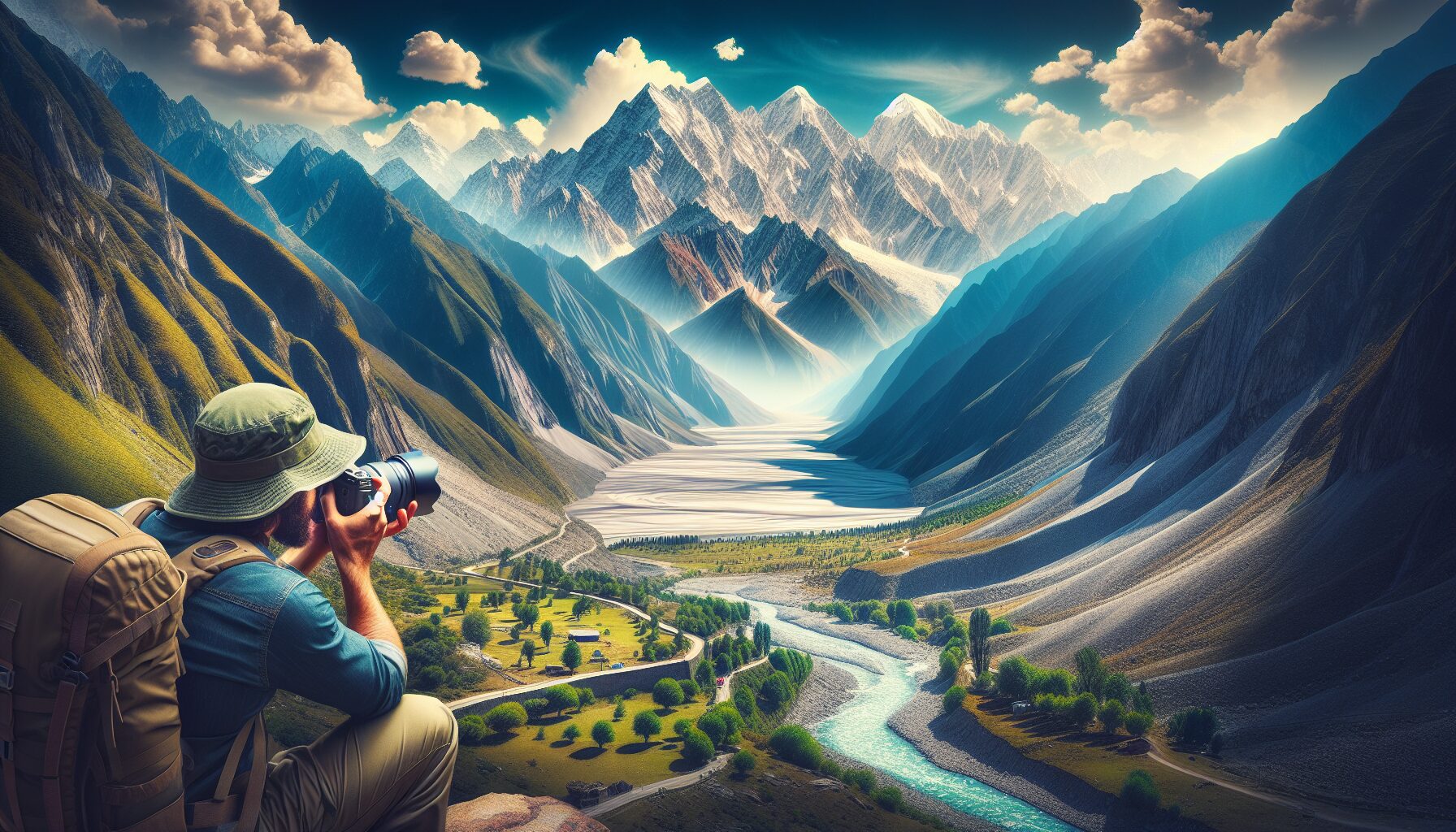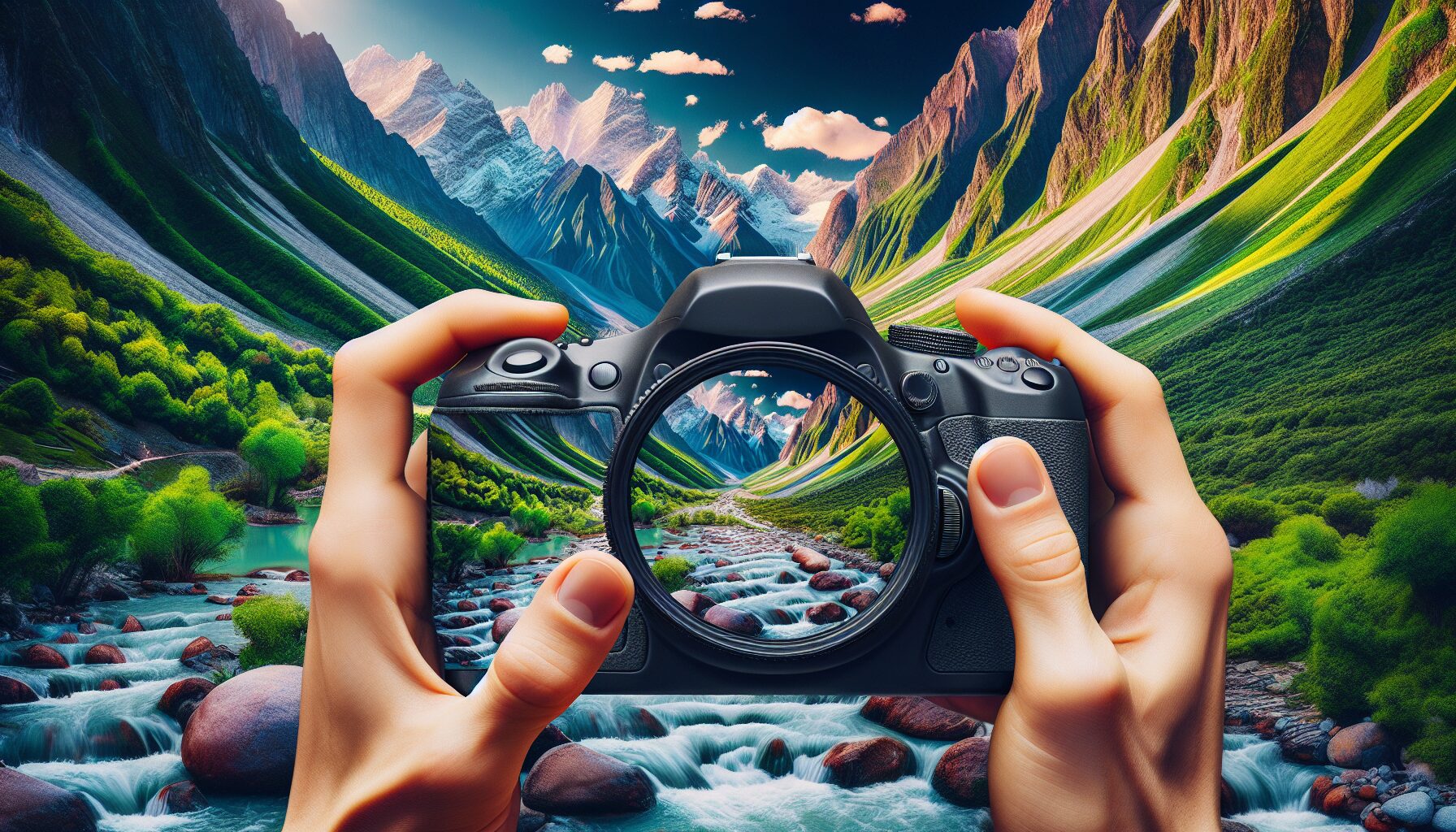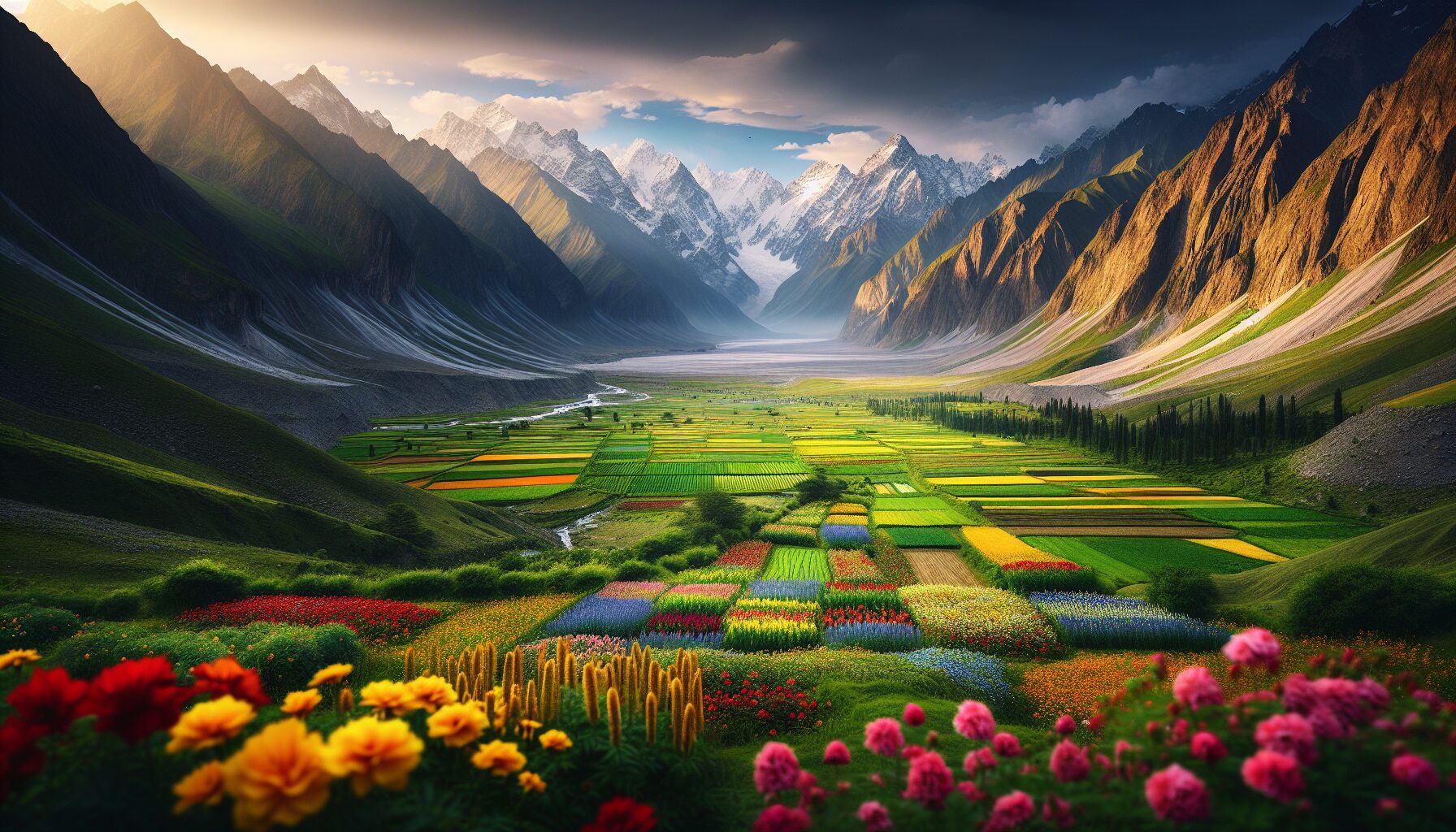To truly capture the essence of Pakistani landscapes, one must explore the diverse terrains that stretch across the country. From the towering peaks of the Karakoram Range to the serene deserts of Thar, each region offers unique photography opportunities. In this journey, tips for epic travel photography become indispensable. I remember my first trip to the lush valleys of Swat; the vibrant colors and breathtaking vistas seemed straight out of a painting. A simple, reliable camera and a willingness to explore led to some of my most cherished shots. Consider visiting Hunza Valley for its stunning views or Deosai National Park to witness its wild beauty. Embrace the diversity of Pakistan’s landscapes, and you’ll find your own unforgettable moments.
Related: The Ultimate Guide to Travel Photography in Pakistan: Capture Culture, Landscapes, and Adventure
Capture the Essence of Pakistani Landscapes: Framing Stunning Shots
When it comes to capturing the diverse beauty of Pakistan’s landscapes, understanding how to frame your shots can make all the difference. Whether you’re standing before the majestic peaks of the Karakoram Range or the serene waters of Lake Saiful Muluk, your composition choices will bring these scenes to life.
Utilize the Rule of Thirds
One of the simplest yet most effective techniques is the rule of thirds. Imagine your viewfinder split into a 3×3 grid. Position key elements along these lines or at their intersections. This method helps in creating balanced and engaging photographs. I remember my first trip to the Hunza Valley, where aligning the mighty Rakaposhi on the grid’s intersection transformed my photo from ordinary to stunning.
Leading Lines
Leading lines are powerful tools to guide the viewer’s eye through your photo. Use natural elements like rivers, roads, or even rows of trees to create depth. On a walk through the lush green fields of Swat, I used the winding road as a leading line to draw attention to the distant mountains. The result was a captivating image that told a story.
Experiment with Perspectives
Don’t hesitate to change your perspective. Crouch low or climb to a higher vantage point. This can dramatically alter the mood and focus of your photograph. During a visit to the ancient ruins of Mohenjo-Daro, capturing the site from a low angle gave a sense of grandeur and history that a standard eye-level shot couldn’t achieve.
By experimenting with these techniques, you can effectively seize the essence of Pakistan’s breathtaking landscapes and create epic travel photography that resonates with viewers.
Tips for Epic Travel Photography in Pakistan: Lighting and Timing

Capturing the breathtaking beauty of Pakistan’s landscapes requires a keen eye for lighting and timing. Whether you’re exploring the serene valleys of Hunza Valley or the rugged terrains of Skardu, understanding these elements can elevate your travel photography to new heights.
Mastering Natural Light
The quality of natural light can completely transform your images. Golden hours, shortly after sunrise and before sunset, provide soft, diffused lighting that enhances the natural beauty of the landscape. I recall my early morning trek in the Fairy Meadows, where the first light of dawn painted the Nanga Parbat in shades of pink and gold. This time of day is perfect for capturing the tranquility and majesty of Pakistan’s mountains.
Timing is Everything
Timing your shots can mean the difference between a good photo and a great one. Consider seasonal variations. For instance, the apricot blossoms in Hunza during spring create a stunning contrast against the snow-capped peaks. According to a report by BBC, these blossoms are a significant seasonal attraction, drawing photographers worldwide.
- Plan your shoots around the weather to capture dramatic skies.
- Use apps to track the sun’s position for optimal lighting.
- Be patient and wait for the perfect moment; sometimes, the best shots happen unexpectedly.
By paying attention to lighting and timing, you can truly capture the essence of Pakistan’s stunning landscapes. These tips will help you convey the country’s diverse beauty through your lens.
Capture the Essence of Pakistani Landscapes: Choosing the Right Gear
Embarking on a journey to capture the beauty of Pakistan’s diverse landscapes demands the right gear. Whether you’re exploring the lush valleys of Swat or the rugged terrains of the Karakoram, having the proper equipment can make all the difference in translating the scene’s grandeur into your photography.
Essential Gear for Pakistani Landscapes
When I first ventured into the breathtaking northern areas, I discovered that a versatile camera is crucial. Consider investing in a DSLR or a mirrorless camera that offers flexibility in changing lenses. I remember using my Canon EOS R during my trek through the Fairy Meadows—it captured the majestic Nanga Parbat with stunning clarity.
- Wide-Angle Lens: Ideal for capturing expansive landscapes. When I shot the sweeping views of Deosai National Park, my wide-angle lens was indispensable.
- Tripod: A sturdy tripod is vital, especially for long-exposure shots. The winds in the Hunza Valley can be unpredictable, so a reliable tripod ensures stability.
- Polarizing Filter: It enhances color contrast and reduces glare, perfect for the sunny days in Skardu.
Don’t underestimate the importance of light and portable gear. During a trek to the remote areas of Baltistan, lightweight equipment allowed me to focus more on the experience and less on lugging heavy gear. For a more comprehensive guide on how to photograph Pakistan’s landscapes and culture, check out our ultimate guide to travel photography in Pakistan.
Incorporating these tools into your kit will set you up for success. You’ll be ready to document the striking landscapes that define Pakistan’s natural allure.
Local Insights for Epic Travel Photography in Pakistan
Picturing the breathtaking beauty of Pakistan is an adventure for any travel photographer. From the rugged mountains of the north to the serene beaches in the south, each region offers its own unique charm. As a local, I’ve discovered some insights that can help you capture the essence of these landscapes.
Timing Is Everything
The golden hours, just after sunrise and before sunset, are ideal for capturing stunning shots. The soft light during these times enhances the natural beauty of landscapes, highlighting textures and adding depth. For instance, the morning mist in Fairy Meadows creates a magical atmosphere that is perfect for photography.
Use Local Knowledge
Always talk to locals to discover hidden gems. They can guide you to spots less traveled by tourists. Once, while exploring the Thar Desert, a friendly local pointed me to a secluded dune that provided a perfect vantage point for a sunset shot.
Essential Gear
- Carry a sturdy tripod to stabilize your camera, especially for long exposures.
- A wide-angle lens is crucial for capturing expansive landscapes like the Karakoram Range.
- Don’t forget a polarizing filter to reduce glare and enhance colors, especially in places like Lake Saiful Muluk.
Lastly, be patient and persistent. Sometimes, waiting for the right moment can lead to that one epic shot that truly embodies the spirit of Pakistan’s landscapes. Whether you’re a seasoned photographer or a beginner, these tips will help you create memorable images that convey the essence of your journey.
Capture the Essence of Pakistani Landscapes: Editing Techniques for Perfect Photos

When it comes to capturing the true essence of Pakistan’s stunning landscapes, post-processing can be your best friend. As a local photographer, I’ve found that editing is essential to bring out the natural beauty of places like the valleys of Hunza or the shores of Gwadar. With the right techniques, you can transform your shots into breathtaking visuals.
Mastering Basic Adjustments
Start with the basics: exposure, contrast, and saturation. Adjust the exposure to ensure your image is neither too dark nor too bright. This is crucial for photos taken during the bright midday sun common in many parts of Pakistan. Increase contrast to make your landscapes pop, and tweak saturation to enhance the natural colors without overdoing it.
Highlighting Local Colors
Pakistan is known for vibrant landscapes. Whether it’s the lush greens of the north or the earthy tones of the desert, use the hue and saturation tools to emphasize these local colors. In one of my trips to Skardu, I found that a slight increase in green saturation made the landscapes come alive.
Advanced Techniques
- Dodge and Burn: Use these tools to add depth. Highlight areas that receive sunlight and darken shadows to create a three-dimensional effect.
- Local Adjustments: Isolate specific areas of the photo to enhance or reduce elements like brightness and sharpness.
Finally, always review your edits to maintain a natural look. Over-editing can detract from the authenticity of Pakistan’s landscapes. With these editing techniques, your photos will truly capture the magic of this diverse country.
Conclusion
In wrapping up our journey through the diverse landscapes of Pakistan, it’s clear that the country offers a photographer’s paradise, each region a unique canvas waiting to be explored. Whether you’re capturing the vibrant colors of the Hunza Valley or the stark beauty of the Thar Desert, the key is to always remain open to the unexpected. I remember one early morning in Skardu, the rising sun painted the peaks of K2 in hues of pink and gold, a moment of pure magic that I almost missed due to a sleepy start.
Practical Tips
To truly encapsulate the essence of Pakistan’s landscapes, consider these practical tips:
- Make use of natural light, especially during the golden hours of sunrise and sunset.
- Experiment with different angles and perspectives to highlight the vastness or intimacy of the scene.
- Don’t shy away from using a polarizing filter to reduce glare and enhance colors.
Share Your Stories
Once you’ve captured your epic shots, consider sharing them with communities like `Pakistan Photography Forum`. Engaging with fellow photographers can provide valuable feedback and inspiration. Additionally, platforms like `Instagram` are perfect for showcasing your work to a global audience.
In essence, capturing the spirit of Pakistan’s landscapes is about more than just technique—it’s about immersing yourself in the culture and environment. Let each shot tell a story, and you’ll find that your photographs not only capture the stunning beauty but also the heart of this incredible country.
Continue Exploring
Unlock the secrets to transforming your travel photos into breathtaking masterpieces with cutting-edge AI tools and expert tips for 2025. Dive into the future of photo editing now!
Frequently Asked Questions
What are the best locations for landscape photography in Pakistan?
Pakistan offers a diverse range of stunning landscapes ideal for photography. Some of the top locations include the Hunza Valley, known for its breathtaking mountain scenery; Skardu, which offers views of the majestic Karakoram Range; and the serene beauty of Swat Valley. Other noteworthy places are Fairy Meadows, Deosai National Park, and the rich cultural landscapes of Gwadar.
How can I capture the vibrant colors of Pakistani landscapes effectively?
To capture the vibrant colors of Pakistani landscapes, consider shooting during the golden hours of sunrise and sunset when the light is soft and enhances natural hues. Utilize a polarizing filter to reduce glare and bring out colors, and shoot in RAW format for greater post-processing flexibility. Experiment with different compositions and angles to highlight the vivid landscapes.
What camera settings are ideal for landscape photography in Pakistan's diverse terrains?
For optimal landscape photography in Pakistan’s diverse terrains, use a small aperture (f/8 to f/16) for a wide depth of field, ensuring sharp focus throughout the scene. Set a low ISO (100 to 200) to minimize noise, and use a tripod for stability, especially in low light. Consider using manual mode to have full control over exposure settings, and bracket your shots to capture a range of exposures for HDR processing.


Leave a Reply